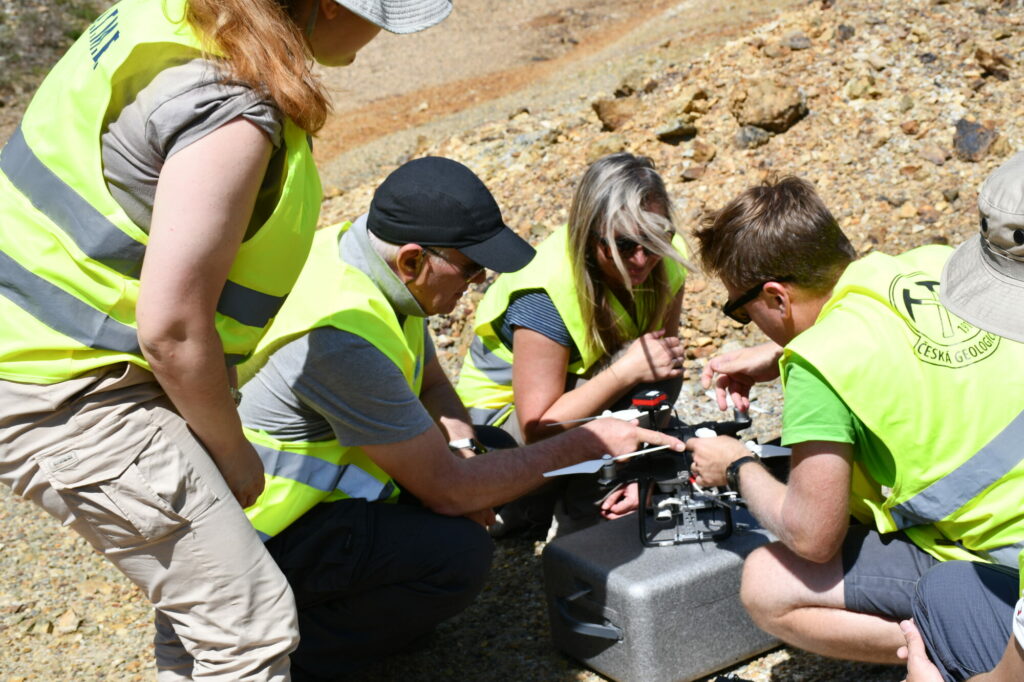Fieldwork in Kirki – Tackling Environmental Challenges in a Historic Mining Area
In May 2024, the MultiMiner project reached a significant milestone with an important fieldwork campaign at the Kirki mining area in Northern Greece. This historically rich site, where mining activities began in 1880 and ceased in 1995, faces ongoing environmental challenges. The area is characterised by abandoned open-pit and underground mines, vast tailings heaps, and severe acid mine drainage (AMD). The fieldwork, conducted by the MultiMiner team in collaboration with GTK, CGS, and HSGME, focused on understanding and mitigating these environmental impacts, utilising both innovative and traditional methods.
One of the primary concerns in the Kirki mining area is the generation of Acid Mine Drainage (AMD), caused by rainwater interacting with mine waste. This results in elevated concentrations of harmful metals in both water and sediments, affecting ecosystems downstream of the abandoned mine. The Kirki mine pit lake and nearby streams, such as the Kirkalon and Eirini, have been severely impacted.

To address this, our team carried out extensive water sampling using both manual methods and cutting-edge drone technology. Water samples were taken from the acidic pit lake and the downstream dam lake, enabling comprehensive water quality analysis. This data is vital for assessing contamination levels and validating the Earth Observation (EO) data used in our machine learning models. By comparing on-ground measurements with EO data, the project ensures that its remote sensing technologies provide accurate environmental assessments.

One of the highlights of this campaign was the use of GTK’s Walkera 1100 Pro drone, equipped with a Drosens sampler. This approach allowed the team to collect water samples from challenging and hazardous locations like the steep pit lake without risking personal safety. Drone-based sampling also proved to be cost-effective and efficient, enabling access to remote or dangerous areas that would otherwise be difficult to sample manually.




Additionally, traditional hand sampling of water and sediment was carried out along the Kirkalon and Eirini streams, where researchers from HSGME, GTK, and CGS coordinated their efforts. The samples were filtered, preserved, and transported to HSGME’s laboratories in Athens for further analysis, including measurements of heavy metals, pH levels, redox status, and other indicators crucial for understanding the extent of AMD in the area.
Alongside water sampling, the field team utilised portable XRF technology to conduct non-destructive analysis of mine waste and rocks. This allowed for real-time assessment of metal concentrations in the waste heaps and mine tailings, providing a detailed picture of the environmental risks posed by these materials. The data collected will help inform rehabilitation strategies aimed at reducing the harmful effects of historic mining activities.
Drone technology was also employed to collect spectral data of the water bodies, adding another layer of insight into the environmental conditions at Kirki. These spectral measurements will be integrated into the development of AMD spectral libraries, helping to improve the accuracy of future Earth Observation-based monitoring efforts. By combining on-site data collection with satellite imagery and machine learning, MultiMiner aims to create scalable, cost-effective tools for monitoring environmental impacts in real-time.
Understanding and mitigating AMD is essential for the successful rehabilitation of historic mining areas like Kirki. This fieldwork not only helps assess the current environmental damage but also supports long-term restoration efforts led by HSGME. The data collected will be crucial for developing effective strategies to reduce contamination, protect local ecosystems, and guide sustainable mining practices in the future.

The May 2024 field campaign in the Kirki mining area highlights the MultiMiner project’s commitment to using innovative technologies alongside traditional methods to address the environmental challenges of abandoned mines. Through drone-based water sampling, real-time XRF data collection, and detailed water quality analysis, the project is laying the groundwork for more accurate environmental assessments and effective remediation strategies. This work directly contributes to rehabilitation efforts in the area and ensures that lessons learned in Kirki will inform sustainable mining practices across Europe and beyond.